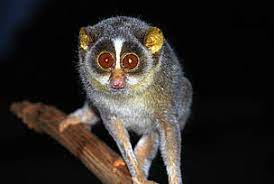Important Facts For Prelims
Grey Slender Loris
- 06 May 2022
- 3 min read
Why in News?
Recently, scientists from the Salim Ali Centre for Ornithology and Natural History (SACON) in Coimbatore carried out a survey of Grey slender loris populations in Tamil Nadu’s Dindigul forest division.
What is Grey Slender Loris?
- About:
- The Grey slender loris belongs to the family Loridae.
- It is a species of primate.
- It has got a lean and lanky appearance, with longer and slender limbs, larger ears, pointed snout and eyes circled with black or dark brown.
- The fur is soft and woolly. The colour varies from dark grey to earthy brown.
- The Grey slender loris is a nocturnal animal. It is also a slow-moving animal. It comes down into the bushes to feed and crosses open stretches of ground to enter isolated groves or to cross from one tree to another.
- Though it is insectivorous, it is fond of berries also.
- The Grey slender loris belongs to the family Loridae.
- Habitat:
- They are found in tropical rainforests, scrub forests, semi-deciduous forests, and swamps.
- Grey Slender Loris generally inhabits dry and drought-prone areas of Dindigul district of Tamil Nadu.
- It is found in acacia and tamarind-dominated thorn and scrub forests near cultivated fields.
- The species occurs in southern and eastern India (Andhra Pradesh, Karnataka, Kerala and Tamil Nadu) and Sri Lanka.
- Types:
- There are two species of Slender Loris, the only members of the genus ‘Loris’:
- Red Slender Loris (Loris tardigradus)
- Grey Slender Loris (Loris lydekkerianus)
- There are two species of Slender Loris, the only members of the genus ‘Loris’:
- Threat:
- The loris has become threatened mainly because of habitat loss.
- The disappearance of the acacia tree, a preferred tree species of the loris, hunting for the pet trade and for their meat, road kills, superstitious kills, traditional medicine and habitat fragmentation pose serious threats to this primate.
- Protection Status:
- IUCN: Near Threatened
- CITES: Appendix II
- Wildlife (Protection) Act of India, 1972: Schedule I
What is Salim Ali Centre for Ornithology and Natural History (SACON)?
- SACON , established in 1990 at Anaikatti, Coimbatore (Tamil Nadu) is a national centre for information, education and research in ornithology and natural history in India.
- It was named after Dr. Salim Ali in appreciation of his lifelong services to India's bird life and conservation of natural resources.
- It designs and conducts research in ornithology covering all aspects of biodiversity and natural history.







